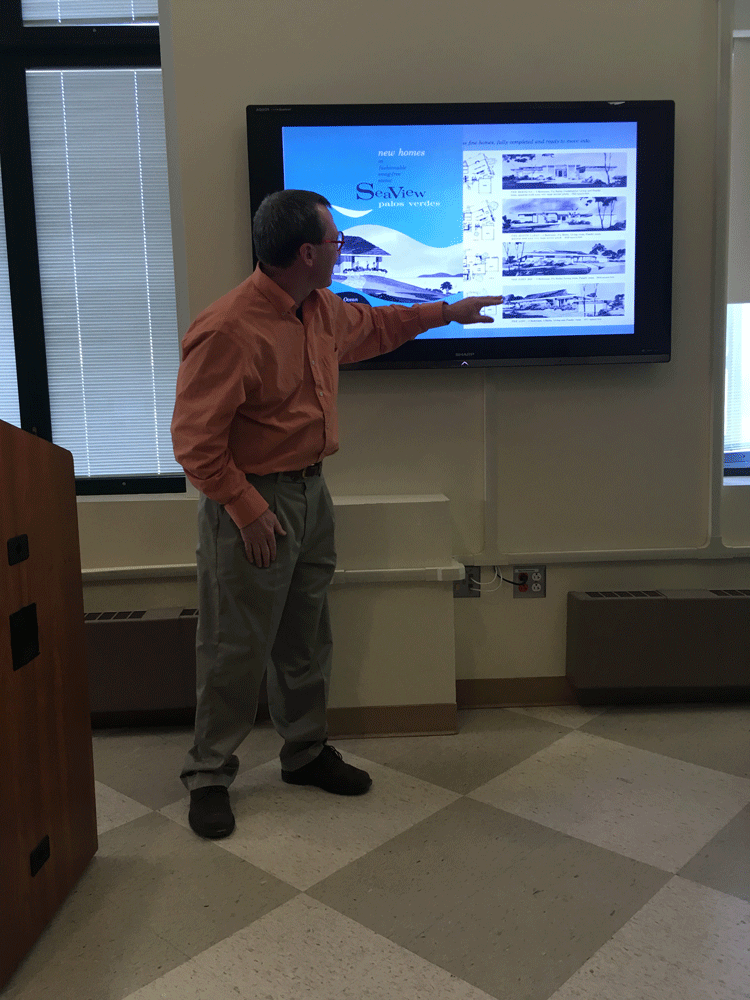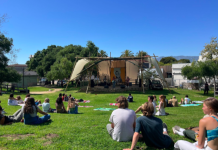
Jack Alegre
Staff Writer
Before the Information Age, there was the Space Age. Before Google, there was Hughes.
The Beach Boys: Classified Research with a Southern California Vibe, an Interdisciplinary Humanities Center presentation by John Hopkins History of Science professor Bill Leslie, analyzed the origins of the practice of creating an accommodating and luxurious environment to promote scientific productivity and the impact it had on developing Southern Californian cities such as Malibu and Huntington Beach.
“I want to turn your attention to how these companies move out from their old [locations] … to suburban locations,” Leslie began on Thursday at HSSB, “and how that changes from a blue collar aesthetic in the old factories to a blue sky aesthetic in these new suburbs.”
Part of the focus of the lecture is on what Leslie calls concierge science. Concierge science is based off the old adage of “All work and no play makes John a dull boy.” Employees find themselves working in an office environment intended to not look like an office environment.
Instead of the suited and restrained images associated with the 1960s—the Mad Men look if you will—there was a certain casualness. To put things in perspective, Leslie gave the example of John D. Williams, a researcher at RAND who had no formal doctorate, and how inconceivable it would be to let someone like that work at a major defense contractor. It was a working environment less about official credentials and propriety and more about creating knowledge and putting that knowledge to use.
In addition to working in an environment that celebrated their genius, scientists working at prolific aerospace companies such as Hughes and RAND could expect to work in a building whose sleek and futuristic look rivaled anything from Europe. One such example was when Leslie compared the architectural style of one of Howard Hughes’ facilities with the mansion from the movie Iron Man.
Another part of the Southern Californian scientific experience was the elitist culture that was maintained for the scientists. Their living spaces may have looked like they were out of the future, but recreation was straight out of the genteel past. Sure, there was sun and surf, but the available amenities maintained a sense of class to separate the scientists from the beach bums. Country clubs and golf courses to rival anything from the more gentrified class could be found.
Interestingly enough, Leslie’s presentation had a twofold purpose. In addition to documenting the glamorous life that scientists involved with cutting edge technology get to lead, it also analyzed the creation and reproduction of class differences amongst workers.
One of the themes that Leslie’s presentation touched on was that of class expectations. He drew inspiration from the book Blue Sky Dream by journalist Daniel Beers. The son of a Lockheed employee, Beers’ book analyzes the difference and disparity between the scientists and laborers and how two integral parts of the aerospace industry could lead such drastically different lives.
Many young scientists came to California not just because the beaches were a nice perk, but because they thought that they deserved them. The promise of a job that wasn’t really a job in exchange for their scientific knowledge ingrained in them the idea that their smarts and talents would merit appropriate rewards.
Contrast the young mens’ (and they were mainly men, Leslie pointed out) dreams of a beachside office with the standard for the laborers: a very plain, grounded, and uniform aesthetic. They received nothing like a campus designed for George Jetson, as Leslie put it. The single family house with the white picket fence was what the laborer’s expected to receive in life because that’s what their reality told them to expect.
Workers didn’t have the same luxuries available to them as their better-educated counterparts. They had to settle for what was given to them and thus hold that as their standard of living. Therefore, creating a fun and privileged atmosphere for the scientists and intellectuals had the adverse effect of widening class differences and reinforcing the idea that different people in different sectors deserved different things.
As a result of the communities’ differentiation from their inception, life was especially hard following California’s aerospace industry crash of the 1990s.
“It put the socially and economically stratified suburbs … on very different trajectories,” Leslie explained. “Blue collar suburbs like Hawthorne and Lakewood, and Inglewood struggled, where Rancho Pineo, Huntington Beach, and Anaheim etc., they took a hit but they ultimately flourished.”
The laborer communities were ingrained to be just that: communities of laborers meant to work heavy machines and take it at that. The more prosperous communities of the scientists and their families could flourish due to higher social standing and the following access to better education and opportunities.
When asked about how he first got started as a history of science professor exploring connections like the sunny California weather to the national defense industry, Leslie was quick to respond.
“I was a failed art history major,” he laughed. “So history of science and its architecture was really a way for me to get back at it and make it my own.”










